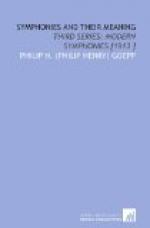In the last movement the composer confesses the “Fantasy” in the title. It begins with a broad sweep of the returning rhapsody, the prologue of the symphony, though without the former conclusion. Now it sings in a strong unison of the strings largamente ed appassionato, and with clang of chord in lower brass. The appealing middle phrase is all disguised in strum as of dance. The various strains sing freely in thirds, with sharp punctuating chords. Throughout is a balance of the pungent vigor of harmonies with dulcet melody.
In sudden rapid pace the strumming figure dances in the lower reed, then yields to the play (in the strings) of a lively (almost comic) tune of a strong national tinge,—a kind that seems native to northern countries and is not unlike a strain that crept into
[Music: Allegro molto]
American song. A tempest of pranks is suddenly halted before the entrance of a broad melody, with underlying harmonies of latent passion. The feeling of fantasy is in the further flow, with free singing chords of harp. But ever between the lines creeps in the strumming phrase, from the first prelude, returned to its earlier mood.
[Music: Andante assai
(Violins) cantabile ed espressivo
(Horns)
(Clarinets)
(Tremolo cellos, with lower C in basses)]
With baffling mystery anon come other appealing phrases from the beginning, that show the whole to be the woof almost of a single figure, or at least to lie within the poetic scope of the prologue. A fugal revel of the comic phrase with the quick strum as counter-theme ends in a new carnival,—here a dashing march, there a mad chase of strident harmonies. Now sings the full romance and passion of the melody through the whole gamut from pathos to rapture. It ends with poignant stress of the essence of the song, with sheerest grating of straining harmonies. In the midst, too, is again the mystic symbol from the heart of the prelude. Then with a springing recoil comes a last jubilation, though still in the prevailing minor, with a final coursing of the quick theme.
The whole is a broad alternation of moods, of wild abandon and of tender feeling,—the natural dual quality of primal music. So, at least in the Finale, this is a Finnish fantasy, on the very lines of other national rhapsody.
CHAPTER XIII
BOHEMIAN SYMPHONIES
In the music of modern Bohemia is one of the most vital utterances of the folk-spirit. The critic may not force a correspondence of politics and art to support his theory. Yet a cause may here be found as in Russia and Finland. (Poland and Hungary had their earlier song). There is a sincerity, an unpremeditated quality in Bohemian music that is not found among its western neighbors. The spirit is its own best proof, without a conscious stress of a national note. Indeed, Bohemian music is




